Is it a perfect 4th?

correct, but the part shown here is for a transposing instrument. it sounds a fifth lower than it is written. so though it is written as A and E, in concert pitch, these notes are actually D and A
I feel like im probably missing a reference but, if not- Is this treble or bass clef? And what’s the tempo?
was written by mahler. no other hints!
I don’t think I’ve ever heard a Mahler piece, but based off of the breath mark and random guessing I’m going to say Symphony no.4 in G major.
answer
mahler symphony 7 mvt 3. it’s a really subtle motif that might be easily mistaken for symphony 1, where a very similar motif is used more prominently. in the 7th, it’d be difficult to catch this motif at all unless you’re looking at the score. guessing which symphony and movement this is from, even knowing it’s mahler, would normally be very hard!
You’re all ridiculous nerds, and I love it
Thanks for resolving it. Can you tell us which part it is?
it’s the english horn 5 measures after rehearsal mark 125
Hey, I’m actually starting to learn how to read scores and I’ve never seen the symbols ’ and > before. What do they mean?
the ’ is a breath mark. in this context, it’s indicating a wind player to breathe at that moment. the same meaning applies to vocalists. it can also appear outside winds or vocalists. in such cases, it means to take a slight pause without necessarily altering tempo (usually by shortening the preceding note) the > is an accent. it indicates to play with greater emphasis. how that emphasis comes through depends on the musical context, but it often means playing that note louder or stronger
Thanks a lot! If I come to have another doubt I’ll surely ask you again, you explained very well
I’ve always been taught that the accent is explicitly not to be treated as playing the note louder or stronger as whole, but rather to emphasize the beginning of the note by quieting the end of the note, i.e. treat the > as a note specific decrescendo
it completely depends on context and interpretation. there isn’t one correct way to play an accent, and you are correct that it doesn’t explicitly mean to play louder. what you’re describing as an accent is kind of like a fortepiano. similarly, what i described as an accent closely aligns with a sfortzando. point is, accents are vague and there isn’t a correct way to play one. more specific styles aren’t necessarily correct, and an interpretation is generally only made unambiguous with notation like the aforementioned fortepianos and sfortzandos
To me an accent isn’t louder in volume, but it’s a stronger or more percussive attack, or start of the note, which may end up slightly louder, but the goal is to strengthen the attack

,’)
‘^,’)
It looks like a winky face and I interpret it as a sliding whistle doing the iconic falling sound
I’m gonna guess that it’s an alto or tenor part, assuming the text was cut off
Despacito





